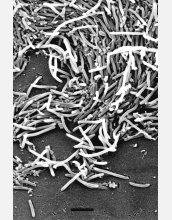Multimedia Gallery
SEM of Heliobacterium chlorum cells
This scanning electron micrograph (SEM) shows Heliobacterium chlorum cells, slow-moving bacterium that have been isolated from the soil in a lab in Bloomington, Ind. (The bar at the bottom of the image equals 5 micrometers.)
More about this Image
First discovered in Thai rice paddies, the microbe known as Heliobacillus mobilis belongs to a group of bacteria called Heliobacteria. These bacteria respond to light and contain a form of chlorophyll that is intermediate to that found in green plants and cyanobacteria--the first bacteria to release oxygen on Earth. Some scientists believe that early forms of cyanobacteria used energy from sunlight to transform the Earth's atmosphere into an oxygen-rich blanket suitable for animal life.
Structural similarities between the two bacteria suggest the possibility that the Heliobacterium chlorum microbe could be the direct descendant of the ancient bacterium that produced cyanobacteria. Further evidence to support this possibility includes the comparison of molecules called ribosomal RNA that are found in Heliobacteria and other microbes. Ribosomal RNA, which plays a crucial role in making proteins, has evolved slowly over the years. The type found in Heliobacterium chlorum closely matches the ribosomal RNA found in some older bacteria that do not respond to light, yet the RNA are strikingly different from that residing in other more common light-sensitive bacteria. The Heliobacterium chlorum related to both cyanobacteria and older, more primitive microbes seems clearly marked as an evolutionary link. (Date of image: Unknown)
Credit: F.R. Turner, Indiana University, Bloomington
Images and other media in the National Science Foundation Multimedia Gallery are available for use in print and electronic material by NSF employees, members of the media, university staff, teachers and the general public. All media in the gallery are intended for personal, educational and nonprofit/non-commercial use only.
Images credited to the National Science Foundation, a federal agency, are in the public domain. The images were created by employees of the United States Government as part of their official duties or prepared by contractors as "works for hire" for NSF. You may freely use NSF-credited images and, at your discretion, credit NSF with a "Courtesy: National Science Foundation" notation.
Additional information about general usage can be found in Conditions.
Also Available:
Download the high-resolution JPG version of the image. (609 KB)
Use your mouse to right-click (Mac users may need to Ctrl-click) the link above and choose the option that will save the file or target to your computer.

